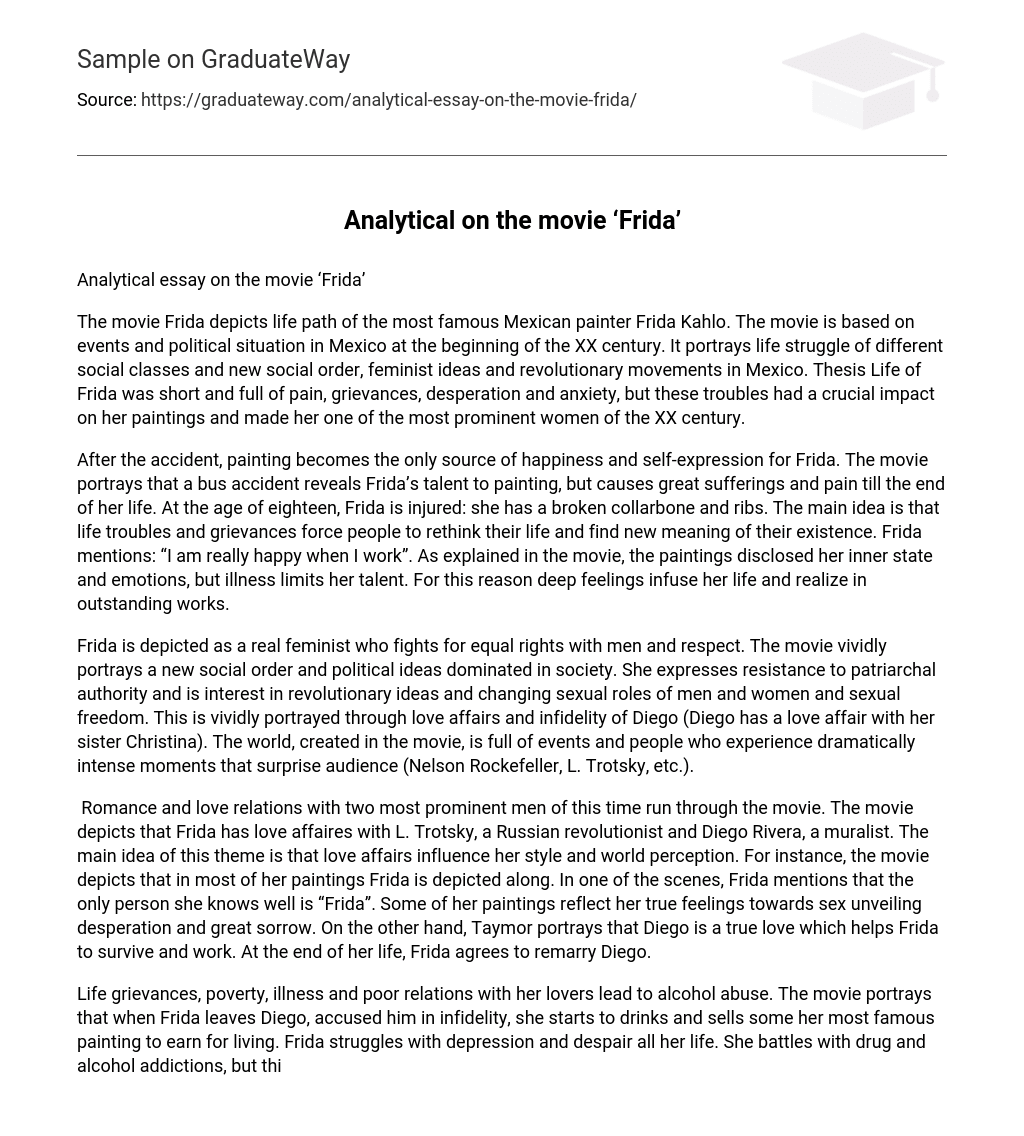The movie Frida depicts life path of the most famous Mexican painter Frida Kahlo. The movie is based on events and political situation in Mexico at the beginning of the XX century. It portrays life struggle of different social classes and new social order, feminist ideas and revolutionary movements in Mexico. Thesis Life of Frida was short and full of pain, grievances, desperation and anxiety, but these troubles had a crucial impact on her paintings and made her one of the most prominent women of the XX century.
After the accident, painting becomes the only source of happiness and self-expression for Frida. The movie portrays that a bus accident reveals Frida’s talent to painting, but causes great sufferings and pain till the end of her life. At the age of eighteen, Frida is injured: she has a broken collarbone and ribs. The main idea is that life troubles and grievances force people to rethink their life and find new meaning of their existence. Frida mentions: “I am really happy when I work”. As explained in the movie, the paintings disclosed her inner state and emotions, but illness limits her talent. For this reason deep feelings infuse her life and realize in outstanding works.
Frida is depicted as a real feminist who fights for equal rights with men and respect. The movie vividly portrays a new social order and political ideas dominated in society. She expresses resistance to patriarchal authority and is interest in revolutionary ideas and changing sexual roles of men and women and sexual freedom. This is vividly portrayed through love affairs and infidelity of Diego (Diego has a love affair with her sister Christina). The world, created in the movie, is full of events and people who experience dramatically intense moments that surprise audience (Nelson Rockefeller, L. Trotsky, etc.).
Romance and love relations with two most prominent men of this time run through the movie. The movie depicts that Frida has love affaires with L. Trotsky, a Russian revolutionist and Diego Rivera, a muralist. The main idea of this theme is that love affairs influence her style and world perception. For instance, the movie depicts that in most of her paintings Frida is depicted along. In one of the scenes, Frida mentions that the only person she knows well is “Frida”. Some of her paintings reflect her true feelings towards sex unveiling desperation and great sorrow. On the other hand, Taymor portrays that Diego is a true love which helps Frida to survive and work. At the end of her life, Frida agrees to remarry Diego.
Life grievances, poverty, illness and poor relations with her lovers lead to alcohol abuse. The movie portrays that when Frida leaves Diego, accused him in infidelity, she starts to drinks and sells some her most famous painting to earn for living. Frida struggles with depression and despair all her life. She battles with drug and alcohol addictions, but this diminishes her physical and physiological pain.
Through minor characters (Tina Modotti and maid) movie explains that Frida remains very much entangled in her own emotions and moods, rather than moving beyond them to real self-understanding and to an awareness of her relationship to her society. Frida writes in her diary: “I hope the exit is joyful–and I hope never to come back – Frida”. She alternates between two moods expansive states of activity, optimism, and power and passive states of contemplation, despondency. Bountiful music supports and renders her moods, feelings and thoughts.
Works Cited
- Frida, Dir, by J. Taymor. Miramax Home Entertainment 2003.





